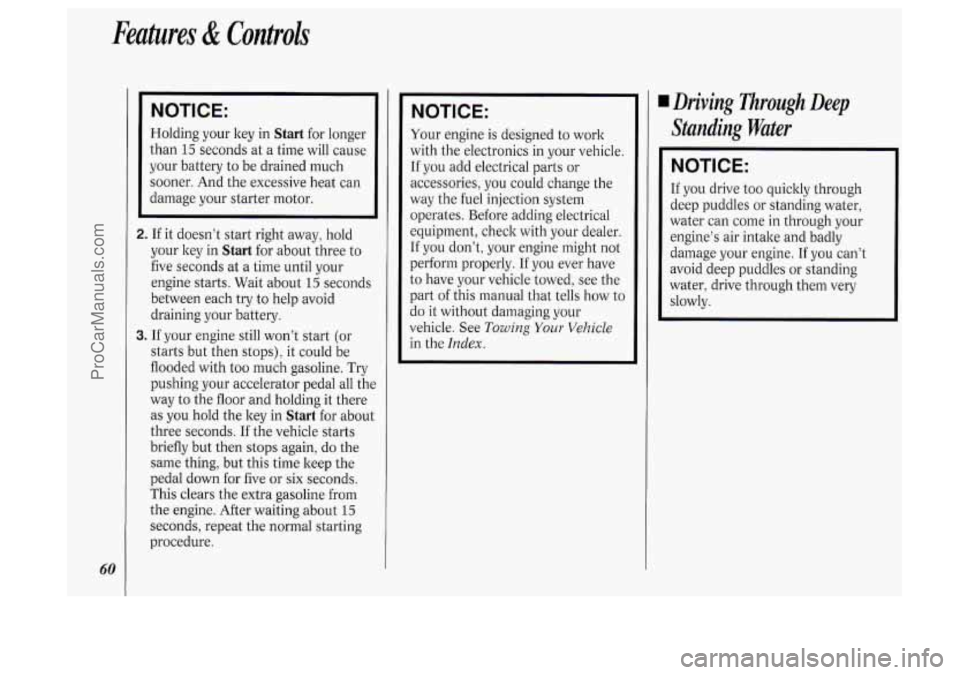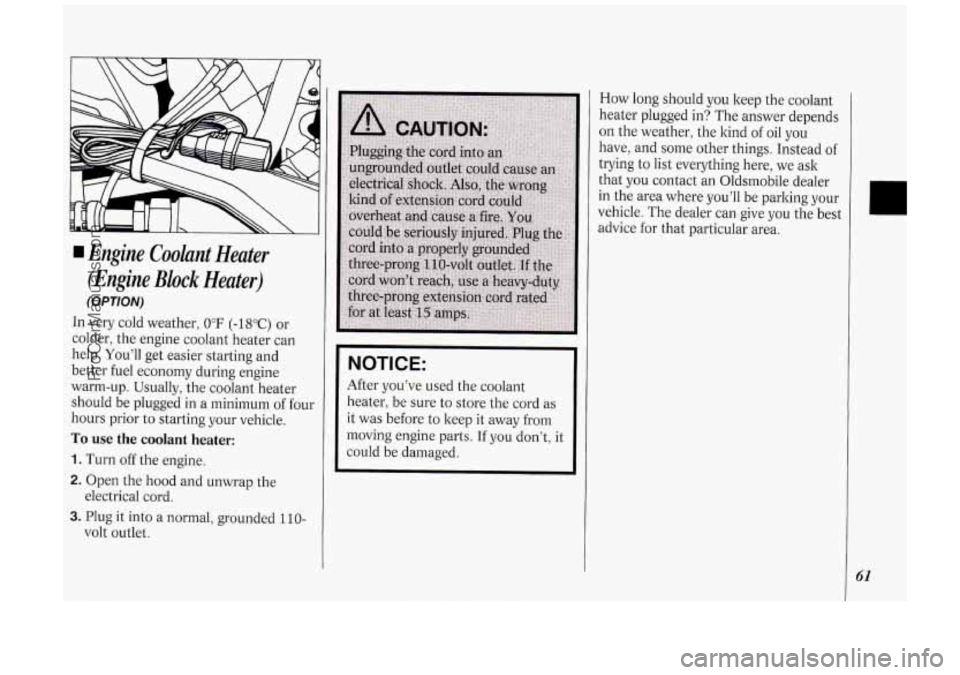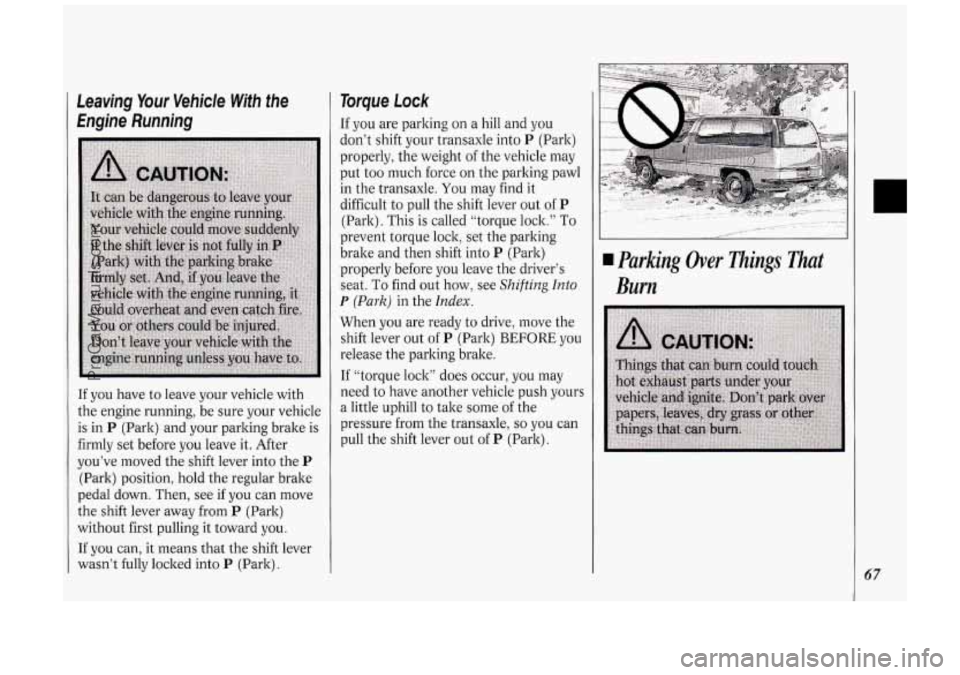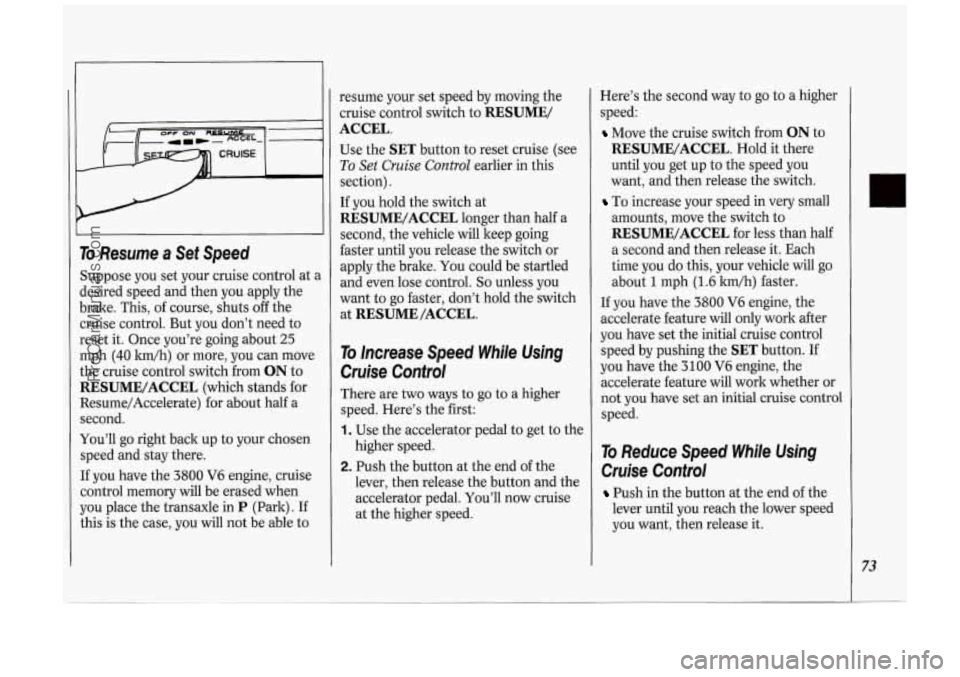Page 62 of 276

Features & Controls
60
NOTICE:
Holding your key in Start for longer
than
15 seconds at a time will cause
your battery to be drained much
sooner. And the excessive heat can
damage your starter motor.
2. If it doesn’t start right away, hold
your key in
Start for about three to
five seconds at a time until your
engine starts. Wait about
15 seconds
between each try to help avoid
draining your battery.
3. If your engine still won’t start (or
starts but then stops), it could be
flooded with too much gasoline. Try
pushing your accelerator pedal all the
way to the floor and holding it there
as you hold the key in
Start for about
three seconds.
If the vehicle starts
briefly but then stops again, do the
same thing, but this time keep the
pedal down for five
or six seconds.
This clears the extra gasoline from
the engine. After waiting about
15
seconds, repeat the normal starting
procedure.
NOTICE:
Your engine is designed to work
with the electronics in your vehicle.
If you add electrical parts or
accessories, you could change the
way the fuel injection system
operates. Before adding electrical
equipment, check with your dealer.
If you don’t, your engine might not
perform properly.
If you ever have
to have your vehicle towed, see the
part of this manual that tells how to
do it without damaging your
vehicle. See
Towing Your Vehicle
in the Index.
I Driving Through Deep
Standing Water
NOTICE:
If you drive too quickly through
deep puddles or standing water,
water can come in through your
engine’s air intake and badly
damage your engine.
If you can’t
avoid deep puddles or standing
water, drive through them very
slowly.
ProCarManuals.com
Page 63 of 276

Engine Cooknt Heater
(Engine
Block Heater)
(OPTION)
In very cold weather, 0°F (-18°C) or
colder, the engine coolant heater can
help. You’ll get easier starting and
better fuel economy during engine
warm-up. Usually, the coolant heater
should be plugged in a minimum of four
hours prior to starting your vehicle.
To use the coolant heater:
1. Turn off the engine.
2. Open the hood and unwrap the
3. Plug it into a normal, grounded 110-
electrical cord.
volt outlet.
NOTICE:
After you’ve used the coolant
heater, be sure to store the cord as
it was before to keep it away from
moving engine parts. If you don’t, it
could be damaged. How
long should you keep the coolant
heater plugged in? The answer depends
on the weather, the kind
of oil you
have, and some other things. Instead
of
trying to list everything here, we ask
that
you contact an Oldsrnobile dealer
in the area where you’ll be parking your
vehicle. The dealer can give you the best
advice for that particular area.
41
ProCarManuals.com
Page 64 of 276
Features & Controls
62
I
Automatic Transaxle
There are several different positions for
your shift lever.
In this manual, these
are referred
to by the commonly used
symbols
in the right column below:
Park P
Reverse
R
Neutral N
Overdrive ID(
Drive D
Second 2
First 1
,-
RNODel]
Park
P (Park): This loclts your front wheels.
It’s the best position
to use when you
start your engine because your vehicle
can’t move easily.
ProCarManuals.com
Page 65 of 276
Reverse
R (Reverse): Use this gear to back up.
NOTICE:
Shifting to R (Reverse) while your
vehicle is moving forward could
damage your transaxle. Shift to
R
only after your vehicle is stopped.
To rock your vehicle back and forth to
get out of snow, ice or sand without
damaging your transaxle, see the
Index
under If You’re Stuck: In Sand, Mud,
Ice
or Snow .
Neutral
N (Neutral):In this position, your
engine doesn’t connect with the wheels.
To restart when you’re already moving,
use N (Neutral) only.
Also, use N when
your vehicle is being towed.
NOTICE:
Damage to your transaxle caused
by shifting out
of P(Park) or N
(Neutral) with the engine racing
isn’t covered by your warranty.
63
ProCarManuals.com
Page 66 of 276

Features & Controls
64
R NoD2l
Forward Gears
(Automatic Overdrive):
If your automatic transaxle has
automatic overdrive, this position is for
normal driving. If you need more power
for passing, and you’re:
Going less than about 35 mph (56
km/h), push your accelerator pedal
about halfway down.
Going about 35 mph (56 Itm/h) or
more, push the accelerator all the way
down.
You’ll shift down
to the next gear and
have more power.
NOTICE:
This NOTICE applies only if you
have the
3800 V6 engine and the
automatic Overdrive transaxle. If
your vehicle
is so equipped, and if it
seems to start up rather slowly, or if
it seems not to shift gears as you go
faster, something may
be wrong
with a transaxle system sensor. If
you drive very far that way, your
vehicle can be damaged.
So, if this
happens, have your vehicle serviced
right away. Until then, you can use
2 (Second Gear) when you are
drivin less than
35 mph (56 ltm/h)
and
d D (Overdrive) for higher
speeds.
D (Third Gear): If your automatic
transaxle does not have Overdrive, this
position is for normal driving, at all
speeds, in most street and highway
situations.
If your automatic transaxle has
Overdrive,
D is like m, but you never
go into Overdrive. Here are some times
you might choose
D instead of m:
When driving on hilly, winding roads.
When towing a trailer, so there is less
When going down a steep hill.
2 (Second Gear): This position gives
you more power but lower fuel
economy. You can use
2 on hills. It can
help control your speed as you go down
steep mountain roads, but then you
would also want to use your brakes
off
and on.
shifting between gears.
NOTICE:
Don’t drive in 2 (Second Gear) for
more than
5 miles (8 ltm), or at
speeds over
55 mph (88 ltm/h), or
you can damage your transaxle.
Use
D (m or D if your vehicle has
Overdrive) as much as possible.
Don’t shift into
2 unless you are
going slower than
65 mph (105
ltm/h), or you can damage your
engine.
1 (First Gear): This position gives you
even more power (but lower fuel
economy) than
2. You can use it on
very steep hills, or in deep snow or
ProCarManuals.com
Page 69 of 276

Leaving Your Vehicle With the
Engine Running
If you have to leave your vehicle with
the engine running, be sure your vehicle
is in
P (Park) and your parking brake is
firmly set before you leave it. After
you’ve moved the shift lever into the
P
(Park) position, hold the regular brake
pedal down. Then, see if you can move
the shift lever away from
P (Park)
without first pulling it toward you.
If you can, it means that the shift lever
wasn’t fully locked into
P (Park).
Torque Lock
If you are parking on a hill and you
don’t shift your transaxle into
P (Park)
properly, the weight
of the vehicle may
put too much force on the parking pawl
in the transaxle. You may find it
difficult to pull the shift lever out of
P
(Park). This is called “torque lock.” To
prevent torque lock, set the parking
brake and then shift into
P (Park)
properly before you leave the driver’s
seat. To find out how, see
Shifting Into
P (Park) in the Index.
When you are ready to drive, move the
shift lever out of
P (Park) BEFORE you
release the parking brake.
If “torque lock’’ does occur, you may
need to have another vehicle push yours
a little uphill to take some
of the
pressure from the transaxle,
so you can
pull the shift lever out of
P (Park).
Parking Over nings That
Burn
67
ProCarManuals.com
Page 70 of 276
Features & Controls
68
I Engine Exhaust
I Running Your Engine While
You 're Parked
It's better not to park with the engine
running. But
if you ever have to, here
are
some things to know.
ProCarManuals.com
Page 75 of 276

ro Resume a Set Speed
Suppose you set your cruise control at a
lesired speed and then you apply the
brake. This, of course, shuts
off the
mise control. But you don’t need to
reset it. Once you’re going about
25
rnph (40 km/h) or more, you can move
the cruise control- switch from
ON to
RESUME/ACCEL (which stands for
Resume/Accelerate) for about half a
second.
You’ll go right back up to your chosen
speed and stay there.
If you have the
3800 V6 engine, cruise
control memory will be erased when
you place the transaxle in P (Park). If
this is the case, you will not be able to resume
your set speed by moving the
cruise control switch to
RESUME/
ACCEL.
Use the SET button to reset cruise (see
To Set Cruise Control earlier in this
section).
If you hold the switch at
RESUME/ACCEL longer than half a
second, the vehicle will keep going
faster until
you release the switch or
apply the brake. You could be startled
and even lose control.
So unless you
want to go faster, don’t hold the switch
at
RESUME/ACCEL.
To Increase Speed While Using
Cruise Control
There are two ways to go to a higher
speed. Here’s the first:
1. Use the accelerator pedal to get to the
2. Push the button at the end of the
higher
speed.
lever, then release the button and the
accelerator pedal. You’ll now cruise
at the higher speed. Here’s the second
way to go to a higher
speed:
Move the cruise switch from ON to
RESUME/ACCEL. Hold it there
until you get up to the speed you
want, and then release the switch.
To increase your speed in very small
amounts, move the switch to
RESUME/ACCEL for less than half
a second and then release it. Each
time you do this, your vehicle will go
about
1 mph (1.6 km/h) faster.
If you have the 3800 V6 engine, the
accelerate feature will only work after
you have set the initial cruise control
speed by pushing the
SET button. If
you have the
3100 V6 engine, the
accelerate feature will work whether or
not you have set an initial cruise control
speed.
To Reduce Speed While Using
Cruise Control
Push in the button at the end of the
lever until you reach the lower speed
you want, then release it.
73
ProCarManuals.com